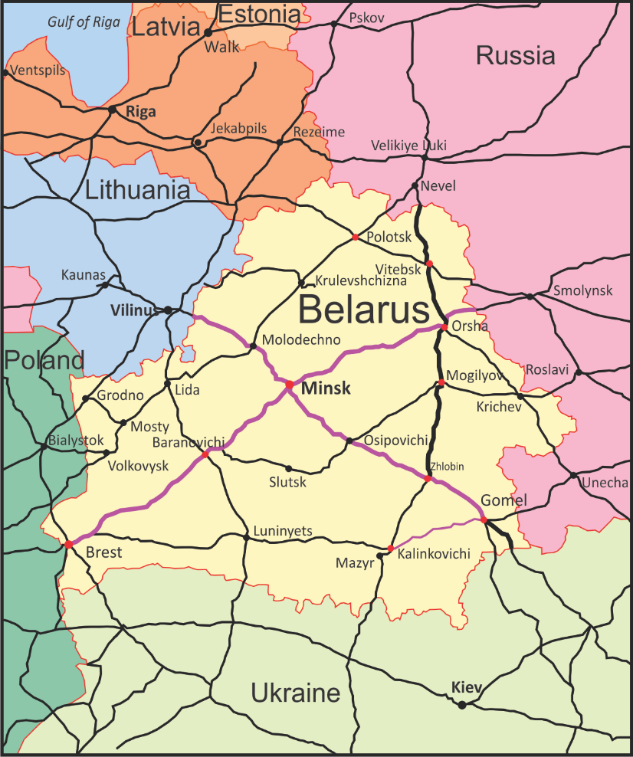If you were to take a train from the Belarusian capital of Minsk to any satellite town, it would likely be cheaper than commuting within the city itself. This sounds like a good deal for inter-city passengers, but it also underscores the challenges facing the long-term development of Belarus’ railway system.
So, how can the railway system be maintained and upgraded to meet new demands, without making train trips unaffordable for ordinary Belarusians?

Let’s roll back momentarily to the 18th century. Back then, the steam-engine was the icon of the First Industrial Revolution, just as the Internet of Things is today driving the so-called Fourth Industrial Revolution. The steam-engine spurred the birth of railways. Railways injected economic growth wherever they were built and forced people to rethink geography.
Railways have a long history here. The first railway line crossing in what is present-day Belarus was the Saint Petersburg-Warsaw Railway. The Porechje-Grono section, part of this railway line, was commissioned as early as 1862.
Over the next 40 years, railway lines were constructed to connect the central areas of the Russian Empire with its western provinces. By the start of the 20th century, Belarus had about 2,800 kilometers of railway line.
Although nearly destroyed in World War I, the railway was rebuilt and then expanded. And in the Second World War, the railway played a significant role in the evacuation of people from Minsk and other areas. After the war, the railway was again rebuilt.
 Today, the Belarusian Railways network extends for some 5,500 kilometers. Employing about 85,000 staff, it is one of the largest employers in Belarus and is a major source of tax revenue. Nearly 75% of rail container traffic between China and Europe flows across the Belarusian Railways.
Today, the Belarusian Railways network extends for some 5,500 kilometers. Employing about 85,000 staff, it is one of the largest employers in Belarus and is a major source of tax revenue. Nearly 75% of rail container traffic between China and Europe flows across the Belarusian Railways.
Despite its geographic advantage, however, Belarusian railways’ share of transit traffic has declined from 35% to 29% over the last decade. This is partly because of the region’s changing political geography and the growth of Russian ports in the Gulf of Finland. The railway also finds itself competing increasingly with road transport for both passenger and freight business.
While international passenger tariffs have increased, regional and local passenger service tariffs have declined considerably. The prices for passenger transport by rail are so low that a 30km rail journey costs less than a metro ride in Minsk.
Belarusian Railways cross-subsidizes loss-making passenger services from freight transport revenues, an obligation that has unfortunately stopped Belarus from making critical investments in its freight network and passenger services, and which even threatens the railway’s financial viability. Rather than burden freight services with the cost of passenger transport, it would make more sense to explore measures to increase revenues for passenger transport and – if they are an essential public service - subsidise them from taxes.
Moreover, Belarusian Railways’ current structure poses several challenges – it isn’t a company in the conventional sense, but a Public Association that supervises 29 different state-owned legal entities, each with its own balance sheet, statement of accounts and assets, and decision-making processes.
So, what’s the way forward?
Several important transformations are required in the railway sector. As such, we have been working closely with Belarusian Railways and the Ministry of Transport & Communications to identify important changes and provide some recommendations.
For instance, Belarus needs a new comprehensive Railway Strategy, one that includes analyses of freight and passenger markets and forecasts, investment needs and requirements, and organizational structures. Reorganization and consolidation of Belarusian Railways into a single state-owned enterprise would make it easier for the railway freight unit to enter into service agreements with private terminal and logistics companies, thereby allowing to set more competitive prices.

Once the new strategy and organizational structures are in place, Belarusian Railways should establish separate business units for freight and passenger activities, each of which could develop commercial strategies, including investment plans and pricing strategies. Business plans should also be developed for the remaining rail sector units, such as infrastructure, rolling stock, and supply units.
I mentioned earlier the Fourth Industrial Revolution. To compete effectively in the rail passenger and freight markets of the 21st century, it’s critical that Belarusian Railways incorporates the strategic use of digital technologies in its business model. Digital technologies can help the sector improve customer service, increase operational efficiency, and ensure better management of infrastructure.
Rail transport is an integral part of our economy and everyday life here – many Belarusians commute to Minsk for work on a regular basis. Providing rail passengers with more comfortable, modern and cost-efficient transportation can significantly improve their daily lives.
_____________________________________________
Find out More – Download the Report (Vol. 1 and 2)
So, how can the railway system be maintained and upgraded to meet new demands, without making train trips unaffordable for ordinary Belarusians?

Let’s roll back momentarily to the 18th century. Back then, the steam-engine was the icon of the First Industrial Revolution, just as the Internet of Things is today driving the so-called Fourth Industrial Revolution. The steam-engine spurred the birth of railways. Railways injected economic growth wherever they were built and forced people to rethink geography.
Railways have a long history here. The first railway line crossing in what is present-day Belarus was the Saint Petersburg-Warsaw Railway. The Porechje-Grono section, part of this railway line, was commissioned as early as 1862.
Over the next 40 years, railway lines were constructed to connect the central areas of the Russian Empire with its western provinces. By the start of the 20th century, Belarus had about 2,800 kilometers of railway line.
Although nearly destroyed in World War I, the railway was rebuilt and then expanded. And in the Second World War, the railway played a significant role in the evacuation of people from Minsk and other areas. After the war, the railway was again rebuilt.
 Today, the Belarusian Railways network extends for some 5,500 kilometers. Employing about 85,000 staff, it is one of the largest employers in Belarus and is a major source of tax revenue. Nearly 75% of rail container traffic between China and Europe flows across the Belarusian Railways.
Today, the Belarusian Railways network extends for some 5,500 kilometers. Employing about 85,000 staff, it is one of the largest employers in Belarus and is a major source of tax revenue. Nearly 75% of rail container traffic between China and Europe flows across the Belarusian Railways.
Despite its geographic advantage, however, Belarusian railways’ share of transit traffic has declined from 35% to 29% over the last decade. This is partly because of the region’s changing political geography and the growth of Russian ports in the Gulf of Finland. The railway also finds itself competing increasingly with road transport for both passenger and freight business.
While international passenger tariffs have increased, regional and local passenger service tariffs have declined considerably. The prices for passenger transport by rail are so low that a 30km rail journey costs less than a metro ride in Minsk.
Belarusian Railways cross-subsidizes loss-making passenger services from freight transport revenues, an obligation that has unfortunately stopped Belarus from making critical investments in its freight network and passenger services, and which even threatens the railway’s financial viability. Rather than burden freight services with the cost of passenger transport, it would make more sense to explore measures to increase revenues for passenger transport and – if they are an essential public service - subsidise them from taxes.
Moreover, Belarusian Railways’ current structure poses several challenges – it isn’t a company in the conventional sense, but a Public Association that supervises 29 different state-owned legal entities, each with its own balance sheet, statement of accounts and assets, and decision-making processes.
So, what’s the way forward?
Several important transformations are required in the railway sector. As such, we have been working closely with Belarusian Railways and the Ministry of Transport & Communications to identify important changes and provide some recommendations.
For instance, Belarus needs a new comprehensive Railway Strategy, one that includes analyses of freight and passenger markets and forecasts, investment needs and requirements, and organizational structures. Reorganization and consolidation of Belarusian Railways into a single state-owned enterprise would make it easier for the railway freight unit to enter into service agreements with private terminal and logistics companies, thereby allowing to set more competitive prices.

Once the new strategy and organizational structures are in place, Belarusian Railways should establish separate business units for freight and passenger activities, each of which could develop commercial strategies, including investment plans and pricing strategies. Business plans should also be developed for the remaining rail sector units, such as infrastructure, rolling stock, and supply units.
I mentioned earlier the Fourth Industrial Revolution. To compete effectively in the rail passenger and freight markets of the 21st century, it’s critical that Belarusian Railways incorporates the strategic use of digital technologies in its business model. Digital technologies can help the sector improve customer service, increase operational efficiency, and ensure better management of infrastructure.
Rail transport is an integral part of our economy and everyday life here – many Belarusians commute to Minsk for work on a regular basis. Providing rail passengers with more comfortable, modern and cost-efficient transportation can significantly improve their daily lives.
_____________________________________________
Find out More – Download the Report (Vol. 1 and 2)


Join the Conversation